Electric Vehicles (EV) Batteries: Ethical and Sustainability Report
VerifiedAdded on 2022/08/17
|11
|3691
|37
Report
AI Summary
This report examines the ethical and sustainability challenges associated with electric vehicle (EV) batteries, focusing on the environmental and social impacts of mineral mining, particularly cobalt, nickel, and aluminum. The analysis begins with a summary of a Corporate Knights article, highlighting concerns such as child labor and environmental damage in mining regions like the Congo and Indonesia. The report then delves into background research, discussing the increasing global adoption of EVs and the associated infrastructure requirements, market drivers, and political considerations. Academic research is incorporated to explore topics like battery life, charging infrastructure, and lithium availability. The report analyzes the strategies of companies like Tesla and Toyota, comparing their approaches to battery production, supply chain management, and marketing. The study concludes by synthesizing the findings, offering insights into the ethical implications, and suggesting avenues for sustainable development in the EV industry, including the importance of responsible mining practices, technological advancements, and corporate responsibility.
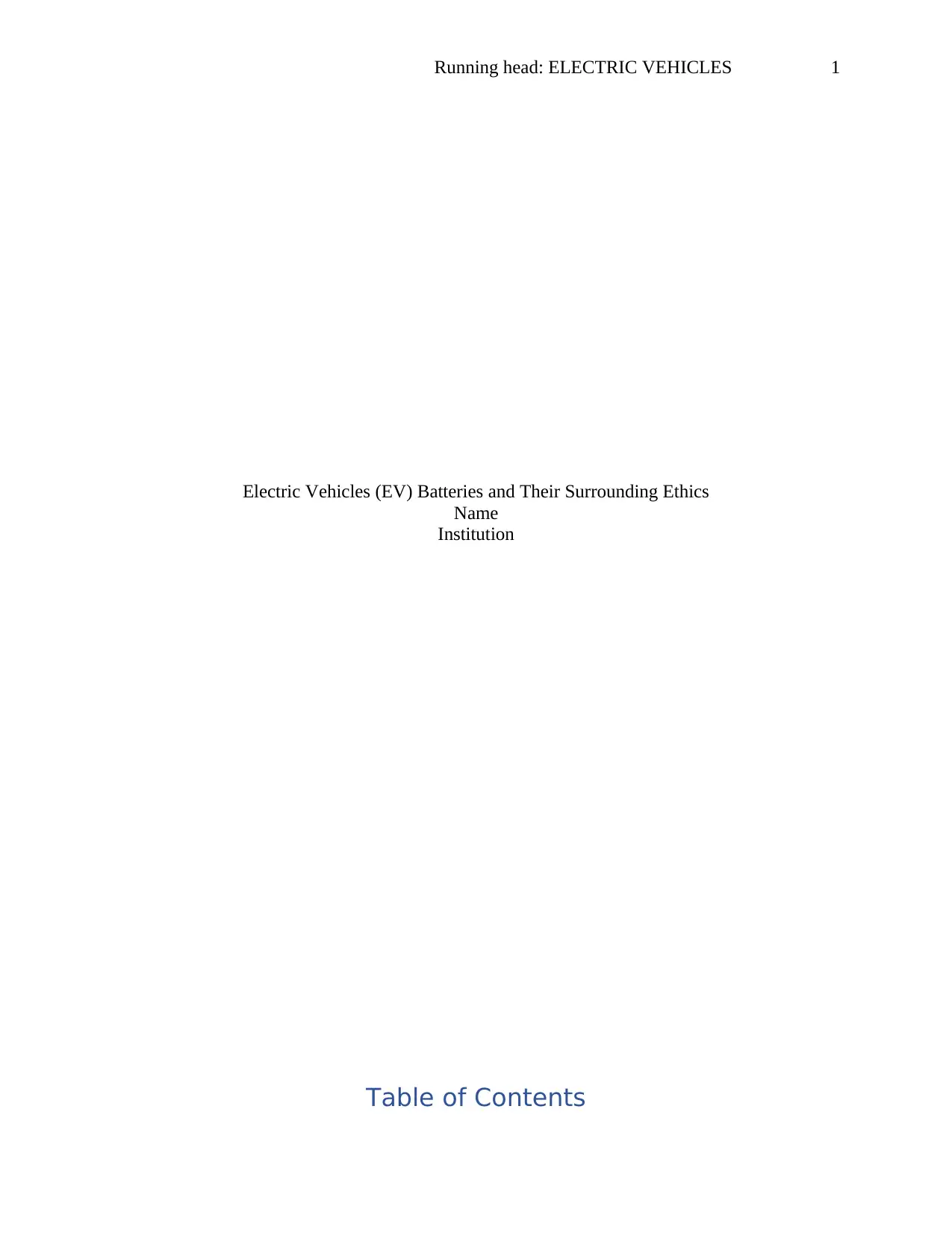
Running head: ELECTRIC VEHICLES 1
Electric Vehicles (EV) Batteries and Their Surrounding Ethics
Name
Institution
Table of Contents
Electric Vehicles (EV) Batteries and Their Surrounding Ethics
Name
Institution
Table of Contents
Paraphrase This Document
Need a fresh take? Get an instant paraphrase of this document with our AI Paraphraser
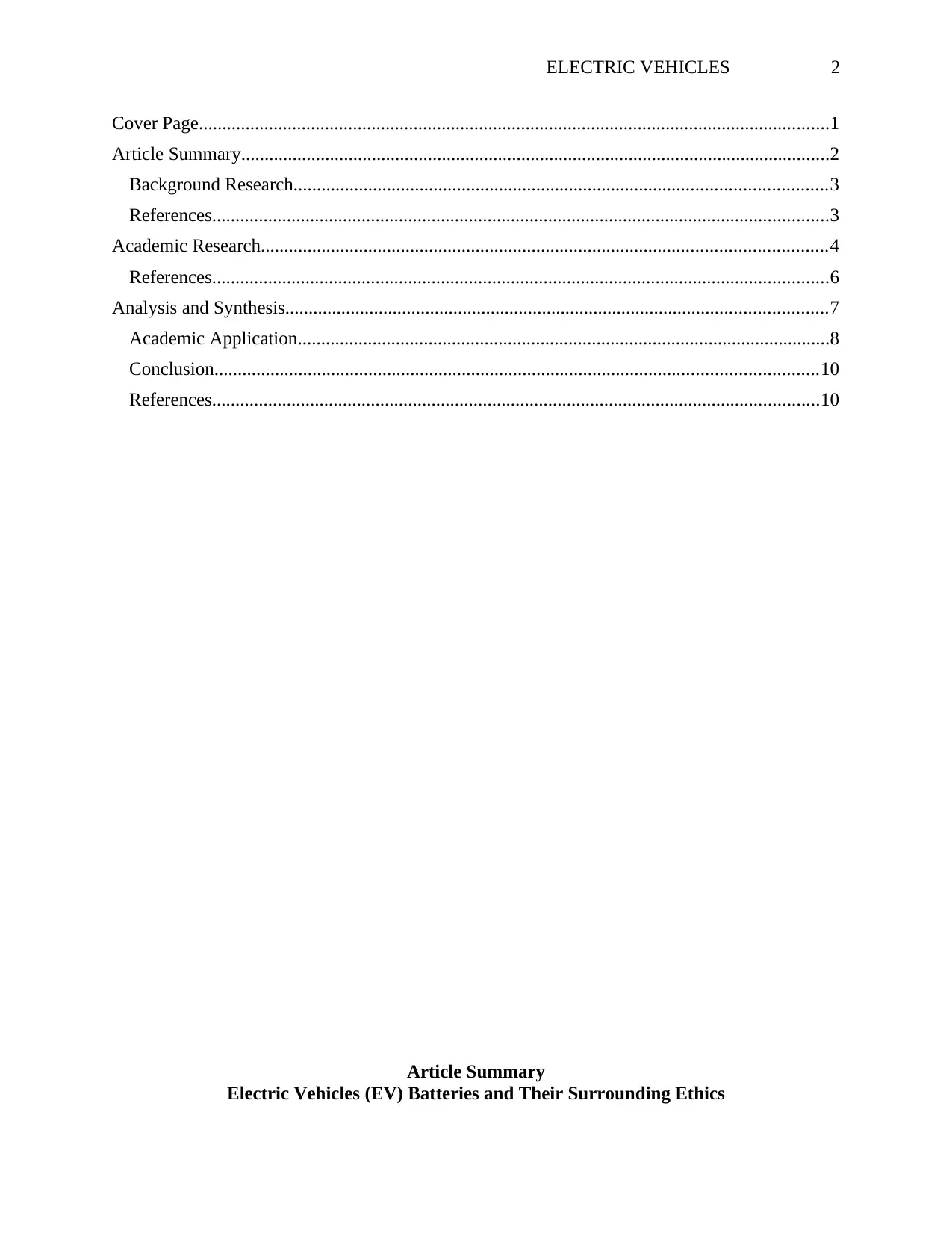
ELECTRIC VEHICLES 2
Cover Page.......................................................................................................................................1
Article Summary..............................................................................................................................2
Background Research..................................................................................................................3
References....................................................................................................................................3
Academic Research.........................................................................................................................4
References....................................................................................................................................6
Analysis and Synthesis....................................................................................................................7
Academic Application..................................................................................................................8
Conclusion.................................................................................................................................10
References..................................................................................................................................10
Article Summary
Electric Vehicles (EV) Batteries and Their Surrounding Ethics
Cover Page.......................................................................................................................................1
Article Summary..............................................................................................................................2
Background Research..................................................................................................................3
References....................................................................................................................................3
Academic Research.........................................................................................................................4
References....................................................................................................................................6
Analysis and Synthesis....................................................................................................................7
Academic Application..................................................................................................................8
Conclusion.................................................................................................................................10
References..................................................................................................................................10
Article Summary
Electric Vehicles (EV) Batteries and Their Surrounding Ethics
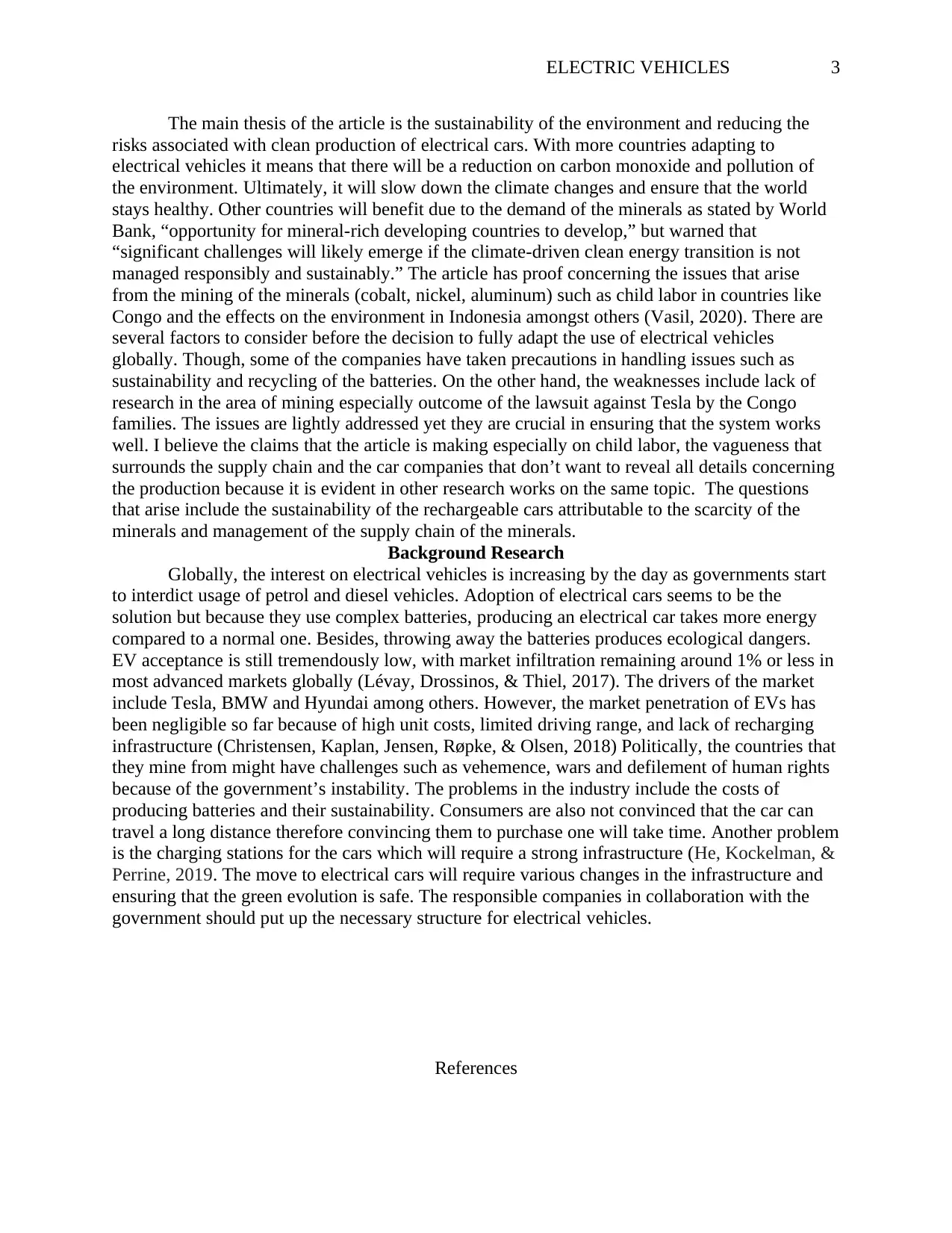
ELECTRIC VEHICLES 3
The main thesis of the article is the sustainability of the environment and reducing the
risks associated with clean production of electrical cars. With more countries adapting to
electrical vehicles it means that there will be a reduction on carbon monoxide and pollution of
the environment. Ultimately, it will slow down the climate changes and ensure that the world
stays healthy. Other countries will benefit due to the demand of the minerals as stated by World
Bank, “opportunity for mineral-rich developing countries to develop,” but warned that
“significant challenges will likely emerge if the climate-driven clean energy transition is not
managed responsibly and sustainably.” The article has proof concerning the issues that arise
from the mining of the minerals (cobalt, nickel, aluminum) such as child labor in countries like
Congo and the effects on the environment in Indonesia amongst others (Vasil, 2020). There are
several factors to consider before the decision to fully adapt the use of electrical vehicles
globally. Though, some of the companies have taken precautions in handling issues such as
sustainability and recycling of the batteries. On the other hand, the weaknesses include lack of
research in the area of mining especially outcome of the lawsuit against Tesla by the Congo
families. The issues are lightly addressed yet they are crucial in ensuring that the system works
well. I believe the claims that the article is making especially on child labor, the vagueness that
surrounds the supply chain and the car companies that don’t want to reveal all details concerning
the production because it is evident in other research works on the same topic. The questions
that arise include the sustainability of the rechargeable cars attributable to the scarcity of the
minerals and management of the supply chain of the minerals.
Background Research
Globally, the interest on electrical vehicles is increasing by the day as governments start
to interdict usage of petrol and diesel vehicles. Adoption of electrical cars seems to be the
solution but because they use complex batteries, producing an electrical car takes more energy
compared to a normal one. Besides, throwing away the batteries produces ecological dangers.
EV acceptance is still tremendously low, with market infiltration remaining around 1% or less in
most advanced markets globally (Lévay, Drossinos, & Thiel, 2017). The drivers of the market
include Tesla, BMW and Hyundai among others. However, the market penetration of EVs has
been negligible so far because of high unit costs, limited driving range, and lack of recharging
infrastructure (Christensen, Kaplan, Jensen, Røpke, & Olsen, 2018) Politically, the countries that
they mine from might have challenges such as vehemence, wars and defilement of human rights
because of the government’s instability. The problems in the industry include the costs of
producing batteries and their sustainability. Consumers are also not convinced that the car can
travel a long distance therefore convincing them to purchase one will take time. Another problem
is the charging stations for the cars which will require a strong infrastructure (He, Kockelman, &
Perrine, 2019. The move to electrical cars will require various changes in the infrastructure and
ensuring that the green evolution is safe. The responsible companies in collaboration with the
government should put up the necessary structure for electrical vehicles.
References
The main thesis of the article is the sustainability of the environment and reducing the
risks associated with clean production of electrical cars. With more countries adapting to
electrical vehicles it means that there will be a reduction on carbon monoxide and pollution of
the environment. Ultimately, it will slow down the climate changes and ensure that the world
stays healthy. Other countries will benefit due to the demand of the minerals as stated by World
Bank, “opportunity for mineral-rich developing countries to develop,” but warned that
“significant challenges will likely emerge if the climate-driven clean energy transition is not
managed responsibly and sustainably.” The article has proof concerning the issues that arise
from the mining of the minerals (cobalt, nickel, aluminum) such as child labor in countries like
Congo and the effects on the environment in Indonesia amongst others (Vasil, 2020). There are
several factors to consider before the decision to fully adapt the use of electrical vehicles
globally. Though, some of the companies have taken precautions in handling issues such as
sustainability and recycling of the batteries. On the other hand, the weaknesses include lack of
research in the area of mining especially outcome of the lawsuit against Tesla by the Congo
families. The issues are lightly addressed yet they are crucial in ensuring that the system works
well. I believe the claims that the article is making especially on child labor, the vagueness that
surrounds the supply chain and the car companies that don’t want to reveal all details concerning
the production because it is evident in other research works on the same topic. The questions
that arise include the sustainability of the rechargeable cars attributable to the scarcity of the
minerals and management of the supply chain of the minerals.
Background Research
Globally, the interest on electrical vehicles is increasing by the day as governments start
to interdict usage of petrol and diesel vehicles. Adoption of electrical cars seems to be the
solution but because they use complex batteries, producing an electrical car takes more energy
compared to a normal one. Besides, throwing away the batteries produces ecological dangers.
EV acceptance is still tremendously low, with market infiltration remaining around 1% or less in
most advanced markets globally (Lévay, Drossinos, & Thiel, 2017). The drivers of the market
include Tesla, BMW and Hyundai among others. However, the market penetration of EVs has
been negligible so far because of high unit costs, limited driving range, and lack of recharging
infrastructure (Christensen, Kaplan, Jensen, Røpke, & Olsen, 2018) Politically, the countries that
they mine from might have challenges such as vehemence, wars and defilement of human rights
because of the government’s instability. The problems in the industry include the costs of
producing batteries and their sustainability. Consumers are also not convinced that the car can
travel a long distance therefore convincing them to purchase one will take time. Another problem
is the charging stations for the cars which will require a strong infrastructure (He, Kockelman, &
Perrine, 2019. The move to electrical cars will require various changes in the infrastructure and
ensuring that the green evolution is safe. The responsible companies in collaboration with the
government should put up the necessary structure for electrical vehicles.
References
⊘ This is a preview!⊘
Do you want full access?
Subscribe today to unlock all pages.

Trusted by 1+ million students worldwide
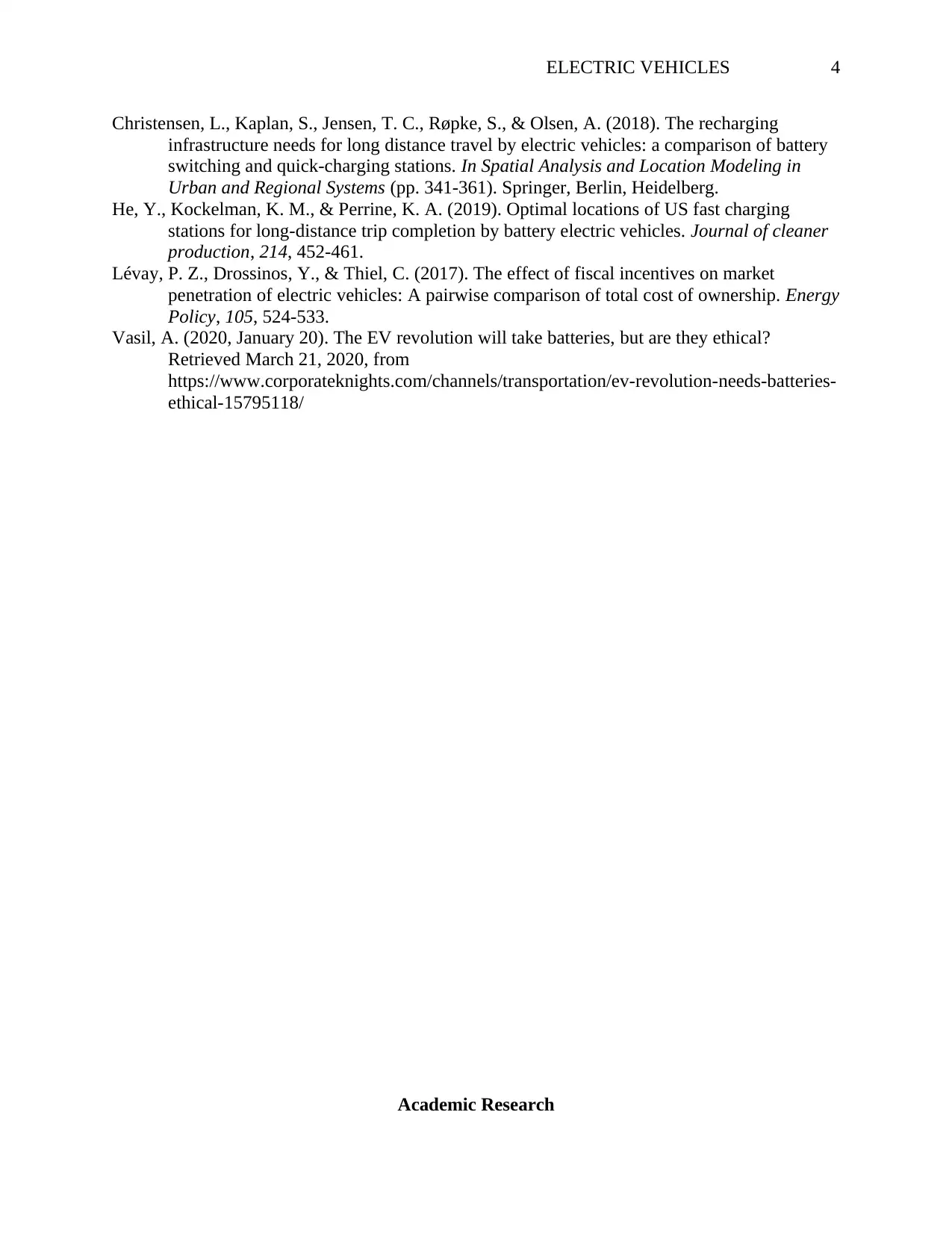
ELECTRIC VEHICLES 4
Christensen, L., Kaplan, S., Jensen, T. C., Røpke, S., & Olsen, A. (2018). The recharging
infrastructure needs for long distance travel by electric vehicles: a comparison of battery
switching and quick-charging stations. In Spatial Analysis and Location Modeling in
Urban and Regional Systems (pp. 341-361). Springer, Berlin, Heidelberg.
He, Y., Kockelman, K. M., & Perrine, K. A. (2019). Optimal locations of US fast charging
stations for long-distance trip completion by battery electric vehicles. Journal of cleaner
production, 214, 452-461.
Lévay, P. Z., Drossinos, Y., & Thiel, C. (2017). The effect of fiscal incentives on market
penetration of electric vehicles: A pairwise comparison of total cost of ownership. Energy
Policy, 105, 524-533.
Vasil, A. (2020, January 20). The EV revolution will take batteries, but are they ethical?
Retrieved March 21, 2020, from
https://www.corporateknights.com/channels/transportation/ev-revolution-needs-batteries-
ethical-15795118/
Academic Research
Christensen, L., Kaplan, S., Jensen, T. C., Røpke, S., & Olsen, A. (2018). The recharging
infrastructure needs for long distance travel by electric vehicles: a comparison of battery
switching and quick-charging stations. In Spatial Analysis and Location Modeling in
Urban and Regional Systems (pp. 341-361). Springer, Berlin, Heidelberg.
He, Y., Kockelman, K. M., & Perrine, K. A. (2019). Optimal locations of US fast charging
stations for long-distance trip completion by battery electric vehicles. Journal of cleaner
production, 214, 452-461.
Lévay, P. Z., Drossinos, Y., & Thiel, C. (2017). The effect of fiscal incentives on market
penetration of electric vehicles: A pairwise comparison of total cost of ownership. Energy
Policy, 105, 524-533.
Vasil, A. (2020, January 20). The EV revolution will take batteries, but are they ethical?
Retrieved March 21, 2020, from
https://www.corporateknights.com/channels/transportation/ev-revolution-needs-batteries-
ethical-15795118/
Academic Research
Paraphrase This Document
Need a fresh take? Get an instant paraphrase of this document with our AI Paraphraser
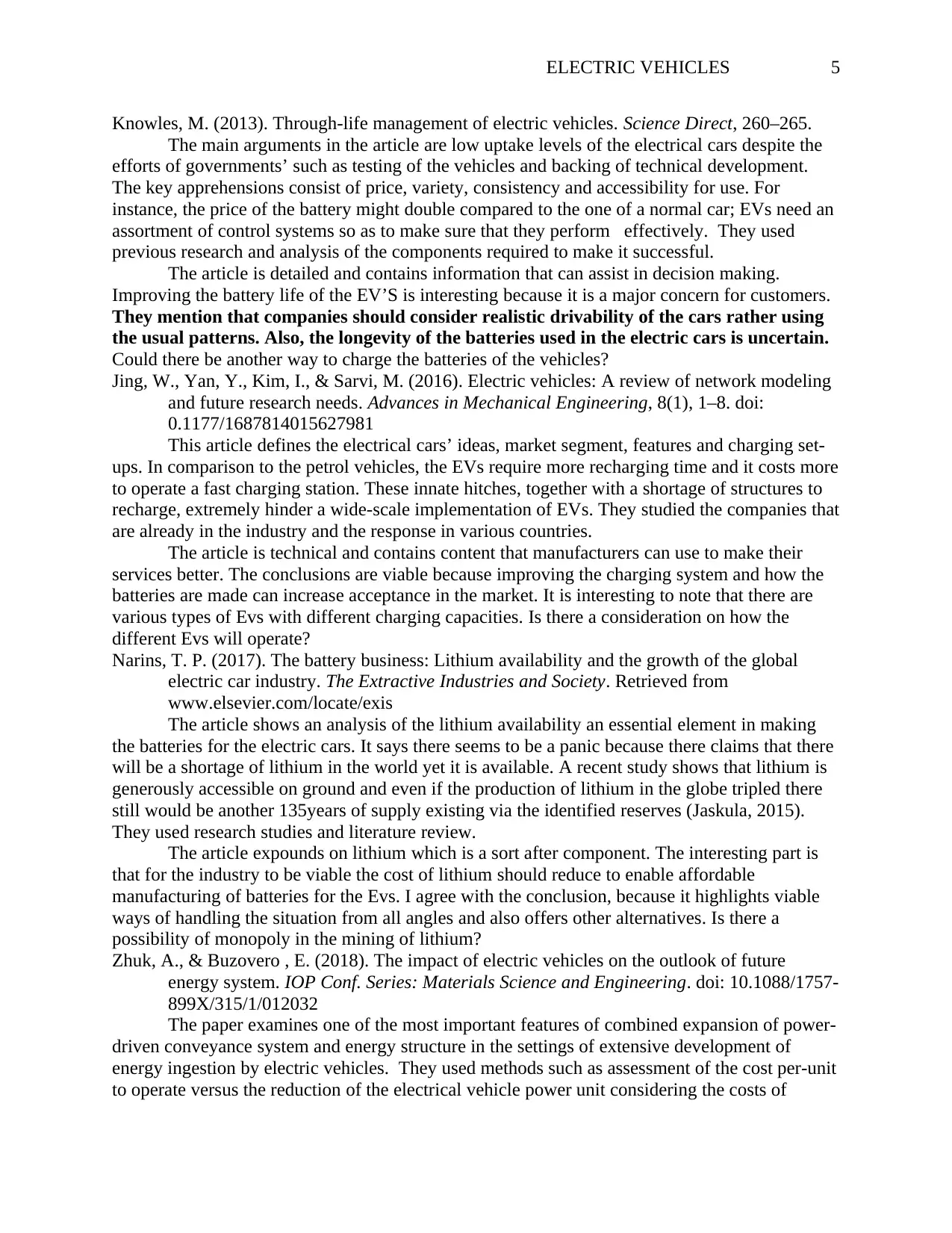
ELECTRIC VEHICLES 5
Knowles, M. (2013). Through-life management of electric vehicles. Science Direct, 260–265.
The main arguments in the article are low uptake levels of the electrical cars despite the
efforts of governments’ such as testing of the vehicles and backing of technical development.
The key apprehensions consist of price, variety, consistency and accessibility for use. For
instance, the price of the battery might double compared to the one of a normal car; EVs need an
assortment of control systems so as to make sure that they perform effectively. They used
previous research and analysis of the components required to make it successful.
The article is detailed and contains information that can assist in decision making.
Improving the battery life of the EV’S is interesting because it is a major concern for customers.
They mention that companies should consider realistic drivability of the cars rather using
the usual patterns. Also, the longevity of the batteries used in the electric cars is uncertain.
Could there be another way to charge the batteries of the vehicles?
Jing, W., Yan, Y., Kim, I., & Sarvi, M. (2016). Electric vehicles: A review of network modeling
and future research needs. Advances in Mechanical Engineering, 8(1), 1–8. doi:
0.1177/1687814015627981
This article defines the electrical cars’ ideas, market segment, features and charging set-
ups. In comparison to the petrol vehicles, the EVs require more recharging time and it costs more
to operate a fast charging station. These innate hitches, together with a shortage of structures to
recharge, extremely hinder a wide-scale implementation of EVs. They studied the companies that
are already in the industry and the response in various countries.
The article is technical and contains content that manufacturers can use to make their
services better. The conclusions are viable because improving the charging system and how the
batteries are made can increase acceptance in the market. It is interesting to note that there are
various types of Evs with different charging capacities. Is there a consideration on how the
different Evs will operate?
Narins, T. P. (2017). The battery business: Lithium availability and the growth of the global
electric car industry. The Extractive Industries and Society. Retrieved from
www.elsevier.com/locate/exis
The article shows an analysis of the lithium availability an essential element in making
the batteries for the electric cars. It says there seems to be a panic because there claims that there
will be a shortage of lithium in the world yet it is available. A recent study shows that lithium is
generously accessible on ground and even if the production of lithium in the globe tripled there
still would be another 135years of supply existing via the identified reserves (Jaskula, 2015).
They used research studies and literature review.
The article expounds on lithium which is a sort after component. The interesting part is
that for the industry to be viable the cost of lithium should reduce to enable affordable
manufacturing of batteries for the Evs. I agree with the conclusion, because it highlights viable
ways of handling the situation from all angles and also offers other alternatives. Is there a
possibility of monopoly in the mining of lithium?
Zhuk, A., & Buzovero , E. (2018). The impact of electric vehicles on the outlook of future
energy system. IOP Conf. Series: Materials Science and Engineering. doi: 10.1088/1757-
899X/315/1/012032
The paper examines one of the most important features of combined expansion of power-
driven conveyance system and energy structure in the settings of extensive development of
energy ingestion by electric vehicles. They used methods such as assessment of the cost per-unit
to operate versus the reduction of the electrical vehicle power unit considering the costs of
Knowles, M. (2013). Through-life management of electric vehicles. Science Direct, 260–265.
The main arguments in the article are low uptake levels of the electrical cars despite the
efforts of governments’ such as testing of the vehicles and backing of technical development.
The key apprehensions consist of price, variety, consistency and accessibility for use. For
instance, the price of the battery might double compared to the one of a normal car; EVs need an
assortment of control systems so as to make sure that they perform effectively. They used
previous research and analysis of the components required to make it successful.
The article is detailed and contains information that can assist in decision making.
Improving the battery life of the EV’S is interesting because it is a major concern for customers.
They mention that companies should consider realistic drivability of the cars rather using
the usual patterns. Also, the longevity of the batteries used in the electric cars is uncertain.
Could there be another way to charge the batteries of the vehicles?
Jing, W., Yan, Y., Kim, I., & Sarvi, M. (2016). Electric vehicles: A review of network modeling
and future research needs. Advances in Mechanical Engineering, 8(1), 1–8. doi:
0.1177/1687814015627981
This article defines the electrical cars’ ideas, market segment, features and charging set-
ups. In comparison to the petrol vehicles, the EVs require more recharging time and it costs more
to operate a fast charging station. These innate hitches, together with a shortage of structures to
recharge, extremely hinder a wide-scale implementation of EVs. They studied the companies that
are already in the industry and the response in various countries.
The article is technical and contains content that manufacturers can use to make their
services better. The conclusions are viable because improving the charging system and how the
batteries are made can increase acceptance in the market. It is interesting to note that there are
various types of Evs with different charging capacities. Is there a consideration on how the
different Evs will operate?
Narins, T. P. (2017). The battery business: Lithium availability and the growth of the global
electric car industry. The Extractive Industries and Society. Retrieved from
www.elsevier.com/locate/exis
The article shows an analysis of the lithium availability an essential element in making
the batteries for the electric cars. It says there seems to be a panic because there claims that there
will be a shortage of lithium in the world yet it is available. A recent study shows that lithium is
generously accessible on ground and even if the production of lithium in the globe tripled there
still would be another 135years of supply existing via the identified reserves (Jaskula, 2015).
They used research studies and literature review.
The article expounds on lithium which is a sort after component. The interesting part is
that for the industry to be viable the cost of lithium should reduce to enable affordable
manufacturing of batteries for the Evs. I agree with the conclusion, because it highlights viable
ways of handling the situation from all angles and also offers other alternatives. Is there a
possibility of monopoly in the mining of lithium?
Zhuk, A., & Buzovero , E. (2018). The impact of electric vehicles on the outlook of future
energy system. IOP Conf. Series: Materials Science and Engineering. doi: 10.1088/1757-
899X/315/1/012032
The paper examines one of the most important features of combined expansion of power-
driven conveyance system and energy structure in the settings of extensive development of
energy ingestion by electric vehicles. They used methods such as assessment of the cost per-unit
to operate versus the reduction of the electrical vehicle power unit considering the costs of
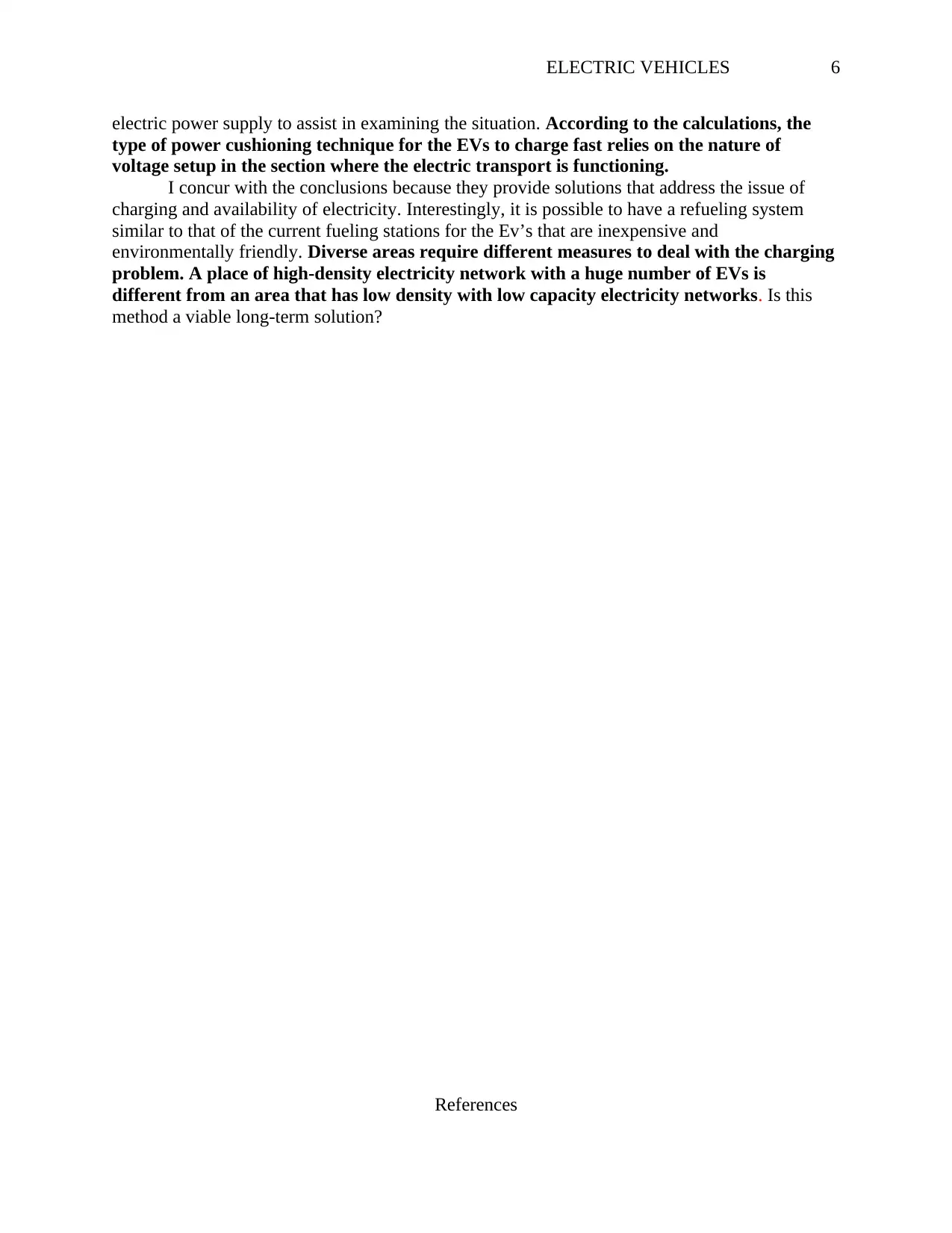
ELECTRIC VEHICLES 6
electric power supply to assist in examining the situation. According to the calculations, the
type of power cushioning technique for the EVs to charge fast relies on the nature of
voltage setup in the section where the electric transport is functioning.
I concur with the conclusions because they provide solutions that address the issue of
charging and availability of electricity. Interestingly, it is possible to have a refueling system
similar to that of the current fueling stations for the Ev’s that are inexpensive and
environmentally friendly. Diverse areas require different measures to deal with the charging
problem. A place of high-density electricity network with a huge number of EVs is
different from an area that has low density with low capacity electricity networks. Is this
method a viable long-term solution?
References
electric power supply to assist in examining the situation. According to the calculations, the
type of power cushioning technique for the EVs to charge fast relies on the nature of
voltage setup in the section where the electric transport is functioning.
I concur with the conclusions because they provide solutions that address the issue of
charging and availability of electricity. Interestingly, it is possible to have a refueling system
similar to that of the current fueling stations for the Ev’s that are inexpensive and
environmentally friendly. Diverse areas require different measures to deal with the charging
problem. A place of high-density electricity network with a huge number of EVs is
different from an area that has low density with low capacity electricity networks. Is this
method a viable long-term solution?
References
⊘ This is a preview!⊘
Do you want full access?
Subscribe today to unlock all pages.

Trusted by 1+ million students worldwide
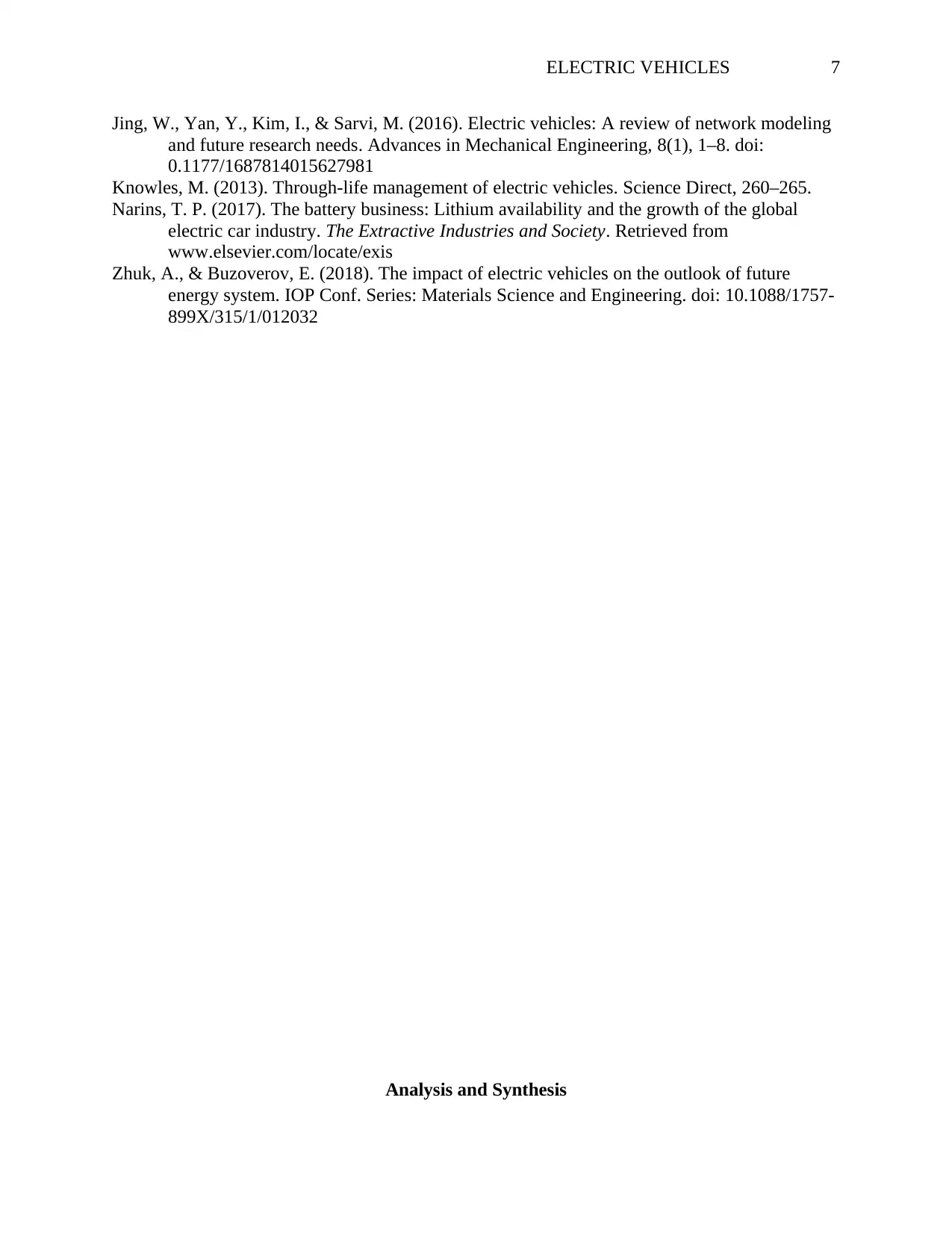
ELECTRIC VEHICLES 7
Jing, W., Yan, Y., Kim, I., & Sarvi, M. (2016). Electric vehicles: A review of network modeling
and future research needs. Advances in Mechanical Engineering, 8(1), 1–8. doi:
0.1177/1687814015627981
Knowles, M. (2013). Through-life management of electric vehicles. Science Direct, 260–265.
Narins, T. P. (2017). The battery business: Lithium availability and the growth of the global
electric car industry. The Extractive Industries and Society. Retrieved from
www.elsevier.com/locate/exis
Zhuk, A., & Buzoverov, E. (2018). The impact of electric vehicles on the outlook of future
energy system. IOP Conf. Series: Materials Science and Engineering. doi: 10.1088/1757-
899X/315/1/012032
Analysis and Synthesis
Jing, W., Yan, Y., Kim, I., & Sarvi, M. (2016). Electric vehicles: A review of network modeling
and future research needs. Advances in Mechanical Engineering, 8(1), 1–8. doi:
0.1177/1687814015627981
Knowles, M. (2013). Through-life management of electric vehicles. Science Direct, 260–265.
Narins, T. P. (2017). The battery business: Lithium availability and the growth of the global
electric car industry. The Extractive Industries and Society. Retrieved from
www.elsevier.com/locate/exis
Zhuk, A., & Buzoverov, E. (2018). The impact of electric vehicles on the outlook of future
energy system. IOP Conf. Series: Materials Science and Engineering. doi: 10.1088/1757-
899X/315/1/012032
Analysis and Synthesis
Paraphrase This Document
Need a fresh take? Get an instant paraphrase of this document with our AI Paraphraser
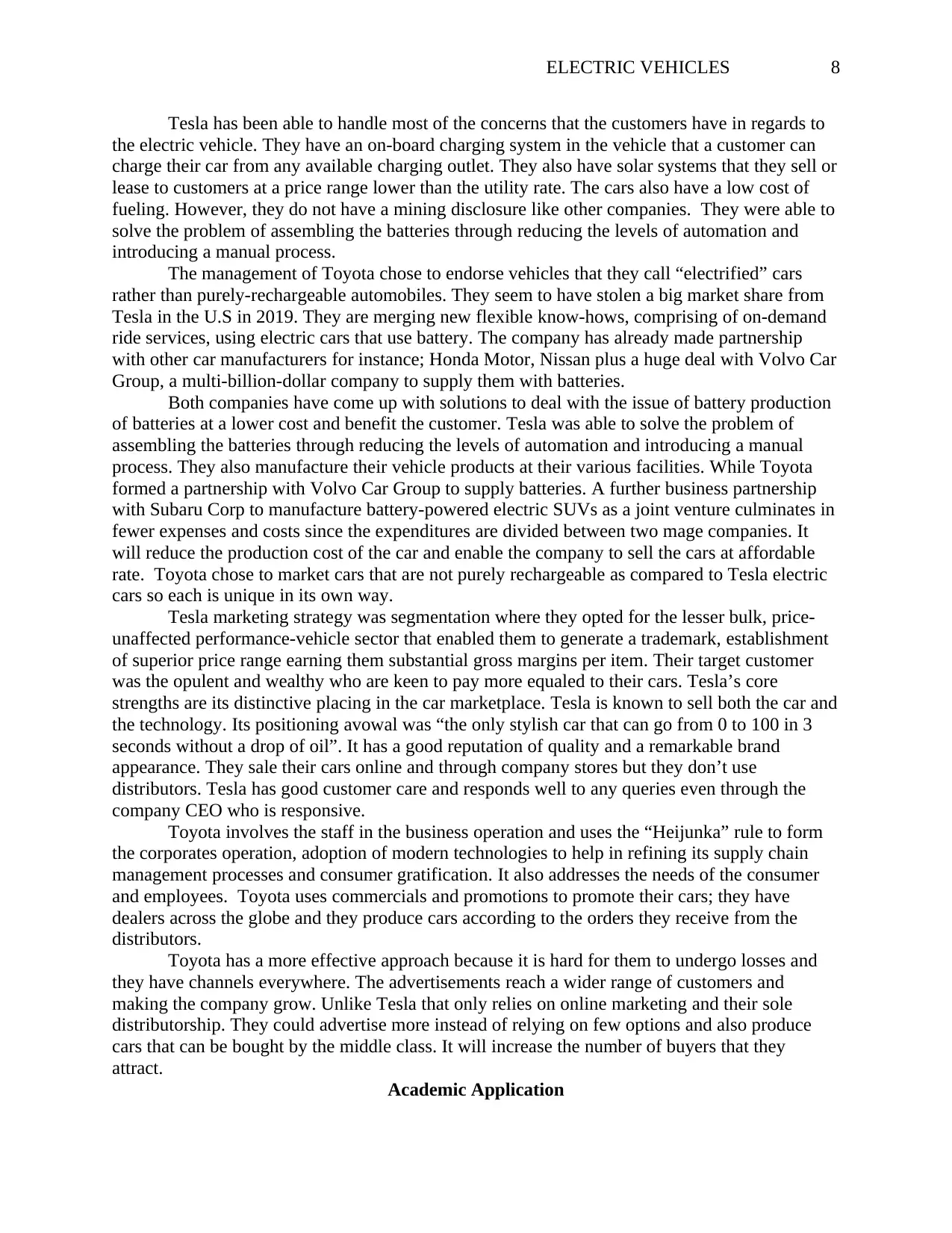
ELECTRIC VEHICLES 8
Tesla has been able to handle most of the concerns that the customers have in regards to
the electric vehicle. They have an on-board charging system in the vehicle that a customer can
charge their car from any available charging outlet. They also have solar systems that they sell or
lease to customers at a price range lower than the utility rate. The cars also have a low cost of
fueling. However, they do not have a mining disclosure like other companies. They were able to
solve the problem of assembling the batteries through reducing the levels of automation and
introducing a manual process.
The management of Toyota chose to endorse vehicles that they call “electrified” cars
rather than purely-rechargeable automobiles. They seem to have stolen a big market share from
Tesla in the U.S in 2019. They are merging new flexible know-hows, comprising of on-demand
ride services, using electric cars that use battery. The company has already made partnership
with other car manufacturers for instance; Honda Motor, Nissan plus a huge deal with Volvo Car
Group, a multi-billion-dollar company to supply them with batteries.
Both companies have come up with solutions to deal with the issue of battery production
of batteries at a lower cost and benefit the customer. Tesla was able to solve the problem of
assembling the batteries through reducing the levels of automation and introducing a manual
process. They also manufacture their vehicle products at their various facilities. While Toyota
formed a partnership with Volvo Car Group to supply batteries. A further business partnership
with Subaru Corp to manufacture battery-powered electric SUVs as a joint venture culminates in
fewer expenses and costs since the expenditures are divided between two mage companies. It
will reduce the production cost of the car and enable the company to sell the cars at affordable
rate. Toyota chose to market cars that are not purely rechargeable as compared to Tesla electric
cars so each is unique in its own way.
Tesla marketing strategy was segmentation where they opted for the lesser bulk, price-
unaffected performance-vehicle sector that enabled them to generate a trademark, establishment
of superior price range earning them substantial gross margins per item. Their target customer
was the opulent and wealthy who are keen to pay more equaled to their cars. Tesla’s core
strengths are its distinctive placing in the car marketplace. Tesla is known to sell both the car and
the technology. Its positioning avowal was “the only stylish car that can go from 0 to 100 in 3
seconds without a drop of oil”. It has a good reputation of quality and a remarkable brand
appearance. They sale their cars online and through company stores but they don’t use
distributors. Tesla has good customer care and responds well to any queries even through the
company CEO who is responsive.
Toyota involves the staff in the business operation and uses the “Heijunka” rule to form
the corporates operation, adoption of modern technologies to help in refining its supply chain
management processes and consumer gratification. It also addresses the needs of the consumer
and employees. Toyota uses commercials and promotions to promote their cars; they have
dealers across the globe and they produce cars according to the orders they receive from the
distributors.
Toyota has a more effective approach because it is hard for them to undergo losses and
they have channels everywhere. The advertisements reach a wider range of customers and
making the company grow. Unlike Tesla that only relies on online marketing and their sole
distributorship. They could advertise more instead of relying on few options and also produce
cars that can be bought by the middle class. It will increase the number of buyers that they
attract.
Academic Application
Tesla has been able to handle most of the concerns that the customers have in regards to
the electric vehicle. They have an on-board charging system in the vehicle that a customer can
charge their car from any available charging outlet. They also have solar systems that they sell or
lease to customers at a price range lower than the utility rate. The cars also have a low cost of
fueling. However, they do not have a mining disclosure like other companies. They were able to
solve the problem of assembling the batteries through reducing the levels of automation and
introducing a manual process.
The management of Toyota chose to endorse vehicles that they call “electrified” cars
rather than purely-rechargeable automobiles. They seem to have stolen a big market share from
Tesla in the U.S in 2019. They are merging new flexible know-hows, comprising of on-demand
ride services, using electric cars that use battery. The company has already made partnership
with other car manufacturers for instance; Honda Motor, Nissan plus a huge deal with Volvo Car
Group, a multi-billion-dollar company to supply them with batteries.
Both companies have come up with solutions to deal with the issue of battery production
of batteries at a lower cost and benefit the customer. Tesla was able to solve the problem of
assembling the batteries through reducing the levels of automation and introducing a manual
process. They also manufacture their vehicle products at their various facilities. While Toyota
formed a partnership with Volvo Car Group to supply batteries. A further business partnership
with Subaru Corp to manufacture battery-powered electric SUVs as a joint venture culminates in
fewer expenses and costs since the expenditures are divided between two mage companies. It
will reduce the production cost of the car and enable the company to sell the cars at affordable
rate. Toyota chose to market cars that are not purely rechargeable as compared to Tesla electric
cars so each is unique in its own way.
Tesla marketing strategy was segmentation where they opted for the lesser bulk, price-
unaffected performance-vehicle sector that enabled them to generate a trademark, establishment
of superior price range earning them substantial gross margins per item. Their target customer
was the opulent and wealthy who are keen to pay more equaled to their cars. Tesla’s core
strengths are its distinctive placing in the car marketplace. Tesla is known to sell both the car and
the technology. Its positioning avowal was “the only stylish car that can go from 0 to 100 in 3
seconds without a drop of oil”. It has a good reputation of quality and a remarkable brand
appearance. They sale their cars online and through company stores but they don’t use
distributors. Tesla has good customer care and responds well to any queries even through the
company CEO who is responsive.
Toyota involves the staff in the business operation and uses the “Heijunka” rule to form
the corporates operation, adoption of modern technologies to help in refining its supply chain
management processes and consumer gratification. It also addresses the needs of the consumer
and employees. Toyota uses commercials and promotions to promote their cars; they have
dealers across the globe and they produce cars according to the orders they receive from the
distributors.
Toyota has a more effective approach because it is hard for them to undergo losses and
they have channels everywhere. The advertisements reach a wider range of customers and
making the company grow. Unlike Tesla that only relies on online marketing and their sole
distributorship. They could advertise more instead of relying on few options and also produce
cars that can be bought by the middle class. It will increase the number of buyers that they
attract.
Academic Application
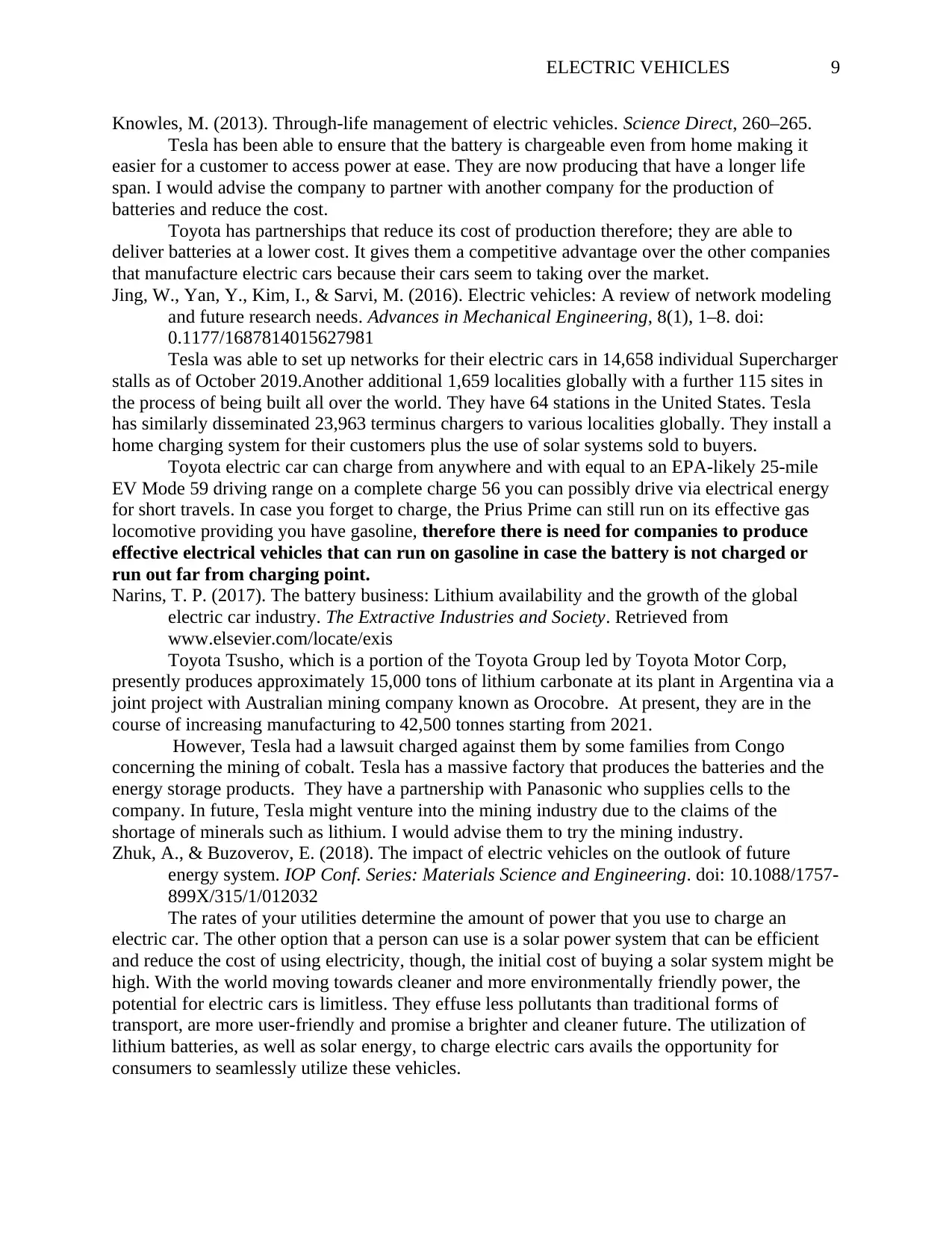
ELECTRIC VEHICLES 9
Knowles, M. (2013). Through-life management of electric vehicles. Science Direct, 260–265.
Tesla has been able to ensure that the battery is chargeable even from home making it
easier for a customer to access power at ease. They are now producing that have a longer life
span. I would advise the company to partner with another company for the production of
batteries and reduce the cost.
Toyota has partnerships that reduce its cost of production therefore; they are able to
deliver batteries at a lower cost. It gives them a competitive advantage over the other companies
that manufacture electric cars because their cars seem to taking over the market.
Jing, W., Yan, Y., Kim, I., & Sarvi, M. (2016). Electric vehicles: A review of network modeling
and future research needs. Advances in Mechanical Engineering, 8(1), 1–8. doi:
0.1177/1687814015627981
Tesla was able to set up networks for their electric cars in 14,658 individual Supercharger
stalls as of October 2019.Another additional 1,659 localities globally with a further 115 sites in
the process of being built all over the world. They have 64 stations in the United States. Tesla
has similarly disseminated 23,963 terminus chargers to various localities globally. They install a
home charging system for their customers plus the use of solar systems sold to buyers.
Toyota electric car can charge from anywhere and with equal to an EPA-likely 25-mile
EV Mode 59 driving range on a complete charge 56 you can possibly drive via electrical energy
for short travels. In case you forget to charge, the Prius Prime can still run on its effective gas
locomotive providing you have gasoline, therefore there is need for companies to produce
effective electrical vehicles that can run on gasoline in case the battery is not charged or
run out far from charging point.
Narins, T. P. (2017). The battery business: Lithium availability and the growth of the global
electric car industry. The Extractive Industries and Society. Retrieved from
www.elsevier.com/locate/exis
Toyota Tsusho, which is a portion of the Toyota Group led by Toyota Motor Corp,
presently produces approximately 15,000 tons of lithium carbonate at its plant in Argentina via a
joint project with Australian mining company known as Orocobre. At present, they are in the
course of increasing manufacturing to 42,500 tonnes starting from 2021.
However, Tesla had a lawsuit charged against them by some families from Congo
concerning the mining of cobalt. Tesla has a massive factory that produces the batteries and the
energy storage products. They have a partnership with Panasonic who supplies cells to the
company. In future, Tesla might venture into the mining industry due to the claims of the
shortage of minerals such as lithium. I would advise them to try the mining industry.
Zhuk, A., & Buzoverov, E. (2018). The impact of electric vehicles on the outlook of future
energy system. IOP Conf. Series: Materials Science and Engineering. doi: 10.1088/1757-
899X/315/1/012032
The rates of your utilities determine the amount of power that you use to charge an
electric car. The other option that a person can use is a solar power system that can be efficient
and reduce the cost of using electricity, though, the initial cost of buying a solar system might be
high. With the world moving towards cleaner and more environmentally friendly power, the
potential for electric cars is limitless. They effuse less pollutants than traditional forms of
transport, are more user-friendly and promise a brighter and cleaner future. The utilization of
lithium batteries, as well as solar energy, to charge electric cars avails the opportunity for
consumers to seamlessly utilize these vehicles.
Knowles, M. (2013). Through-life management of electric vehicles. Science Direct, 260–265.
Tesla has been able to ensure that the battery is chargeable even from home making it
easier for a customer to access power at ease. They are now producing that have a longer life
span. I would advise the company to partner with another company for the production of
batteries and reduce the cost.
Toyota has partnerships that reduce its cost of production therefore; they are able to
deliver batteries at a lower cost. It gives them a competitive advantage over the other companies
that manufacture electric cars because their cars seem to taking over the market.
Jing, W., Yan, Y., Kim, I., & Sarvi, M. (2016). Electric vehicles: A review of network modeling
and future research needs. Advances in Mechanical Engineering, 8(1), 1–8. doi:
0.1177/1687814015627981
Tesla was able to set up networks for their electric cars in 14,658 individual Supercharger
stalls as of October 2019.Another additional 1,659 localities globally with a further 115 sites in
the process of being built all over the world. They have 64 stations in the United States. Tesla
has similarly disseminated 23,963 terminus chargers to various localities globally. They install a
home charging system for their customers plus the use of solar systems sold to buyers.
Toyota electric car can charge from anywhere and with equal to an EPA-likely 25-mile
EV Mode 59 driving range on a complete charge 56 you can possibly drive via electrical energy
for short travels. In case you forget to charge, the Prius Prime can still run on its effective gas
locomotive providing you have gasoline, therefore there is need for companies to produce
effective electrical vehicles that can run on gasoline in case the battery is not charged or
run out far from charging point.
Narins, T. P. (2017). The battery business: Lithium availability and the growth of the global
electric car industry. The Extractive Industries and Society. Retrieved from
www.elsevier.com/locate/exis
Toyota Tsusho, which is a portion of the Toyota Group led by Toyota Motor Corp,
presently produces approximately 15,000 tons of lithium carbonate at its plant in Argentina via a
joint project with Australian mining company known as Orocobre. At present, they are in the
course of increasing manufacturing to 42,500 tonnes starting from 2021.
However, Tesla had a lawsuit charged against them by some families from Congo
concerning the mining of cobalt. Tesla has a massive factory that produces the batteries and the
energy storage products. They have a partnership with Panasonic who supplies cells to the
company. In future, Tesla might venture into the mining industry due to the claims of the
shortage of minerals such as lithium. I would advise them to try the mining industry.
Zhuk, A., & Buzoverov, E. (2018). The impact of electric vehicles on the outlook of future
energy system. IOP Conf. Series: Materials Science and Engineering. doi: 10.1088/1757-
899X/315/1/012032
The rates of your utilities determine the amount of power that you use to charge an
electric car. The other option that a person can use is a solar power system that can be efficient
and reduce the cost of using electricity, though, the initial cost of buying a solar system might be
high. With the world moving towards cleaner and more environmentally friendly power, the
potential for electric cars is limitless. They effuse less pollutants than traditional forms of
transport, are more user-friendly and promise a brighter and cleaner future. The utilization of
lithium batteries, as well as solar energy, to charge electric cars avails the opportunity for
consumers to seamlessly utilize these vehicles.
⊘ This is a preview!⊘
Do you want full access?
Subscribe today to unlock all pages.

Trusted by 1+ million students worldwide
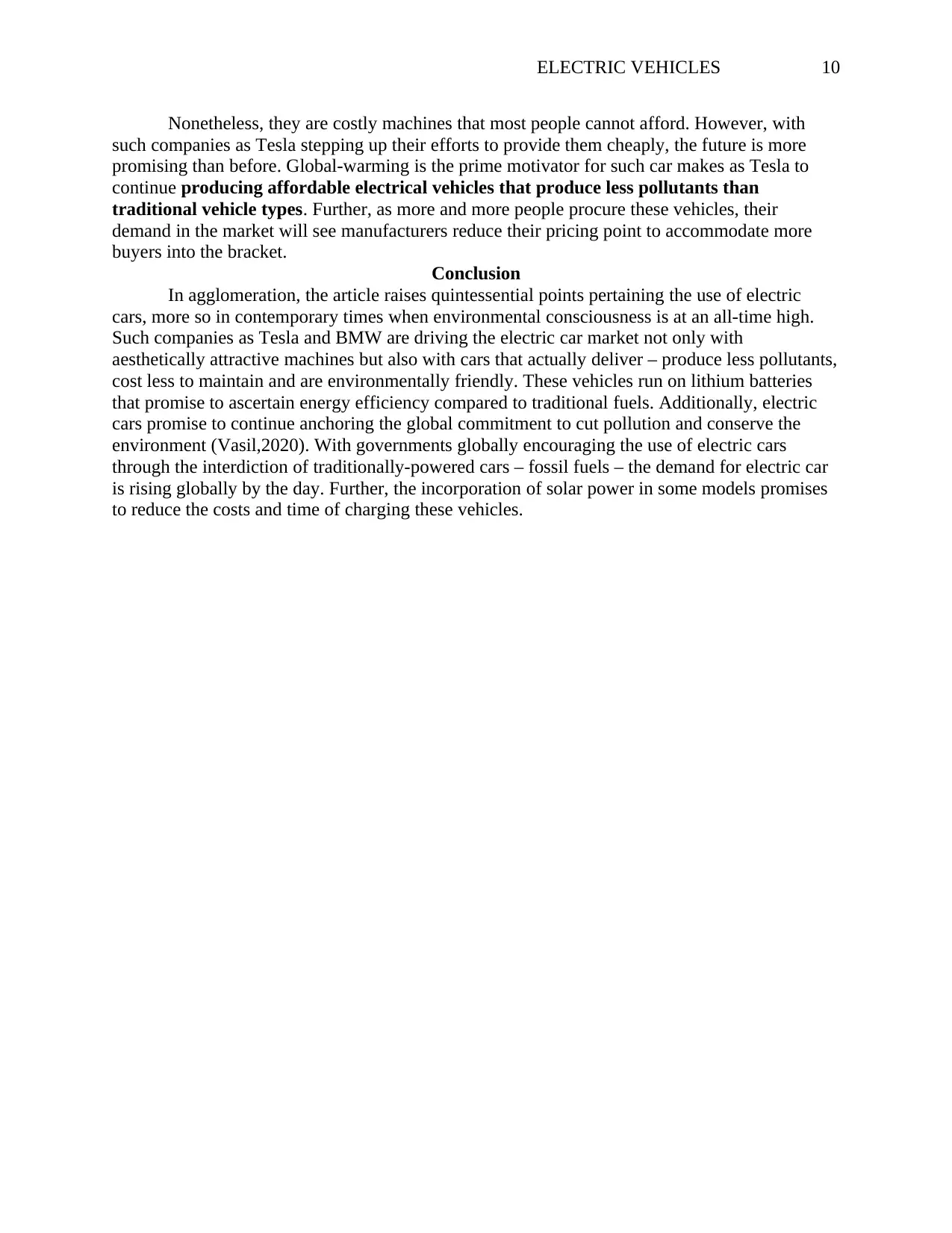
ELECTRIC VEHICLES 10
Nonetheless, they are costly machines that most people cannot afford. However, with
such companies as Tesla stepping up their efforts to provide them cheaply, the future is more
promising than before. Global-warming is the prime motivator for such car makes as Tesla to
continue producing affordable electrical vehicles that produce less pollutants than
traditional vehicle types. Further, as more and more people procure these vehicles, their
demand in the market will see manufacturers reduce their pricing point to accommodate more
buyers into the bracket.
Conclusion
In agglomeration, the article raises quintessential points pertaining the use of electric
cars, more so in contemporary times when environmental consciousness is at an all-time high.
Such companies as Tesla and BMW are driving the electric car market not only with
aesthetically attractive machines but also with cars that actually deliver – produce less pollutants,
cost less to maintain and are environmentally friendly. These vehicles run on lithium batteries
that promise to ascertain energy efficiency compared to traditional fuels. Additionally, electric
cars promise to continue anchoring the global commitment to cut pollution and conserve the
environment (Vasil,2020). With governments globally encouraging the use of electric cars
through the interdiction of traditionally-powered cars – fossil fuels – the demand for electric car
is rising globally by the day. Further, the incorporation of solar power in some models promises
to reduce the costs and time of charging these vehicles.
Nonetheless, they are costly machines that most people cannot afford. However, with
such companies as Tesla stepping up their efforts to provide them cheaply, the future is more
promising than before. Global-warming is the prime motivator for such car makes as Tesla to
continue producing affordable electrical vehicles that produce less pollutants than
traditional vehicle types. Further, as more and more people procure these vehicles, their
demand in the market will see manufacturers reduce their pricing point to accommodate more
buyers into the bracket.
Conclusion
In agglomeration, the article raises quintessential points pertaining the use of electric
cars, more so in contemporary times when environmental consciousness is at an all-time high.
Such companies as Tesla and BMW are driving the electric car market not only with
aesthetically attractive machines but also with cars that actually deliver – produce less pollutants,
cost less to maintain and are environmentally friendly. These vehicles run on lithium batteries
that promise to ascertain energy efficiency compared to traditional fuels. Additionally, electric
cars promise to continue anchoring the global commitment to cut pollution and conserve the
environment (Vasil,2020). With governments globally encouraging the use of electric cars
through the interdiction of traditionally-powered cars – fossil fuels – the demand for electric car
is rising globally by the day. Further, the incorporation of solar power in some models promises
to reduce the costs and time of charging these vehicles.
Paraphrase This Document
Need a fresh take? Get an instant paraphrase of this document with our AI Paraphraser
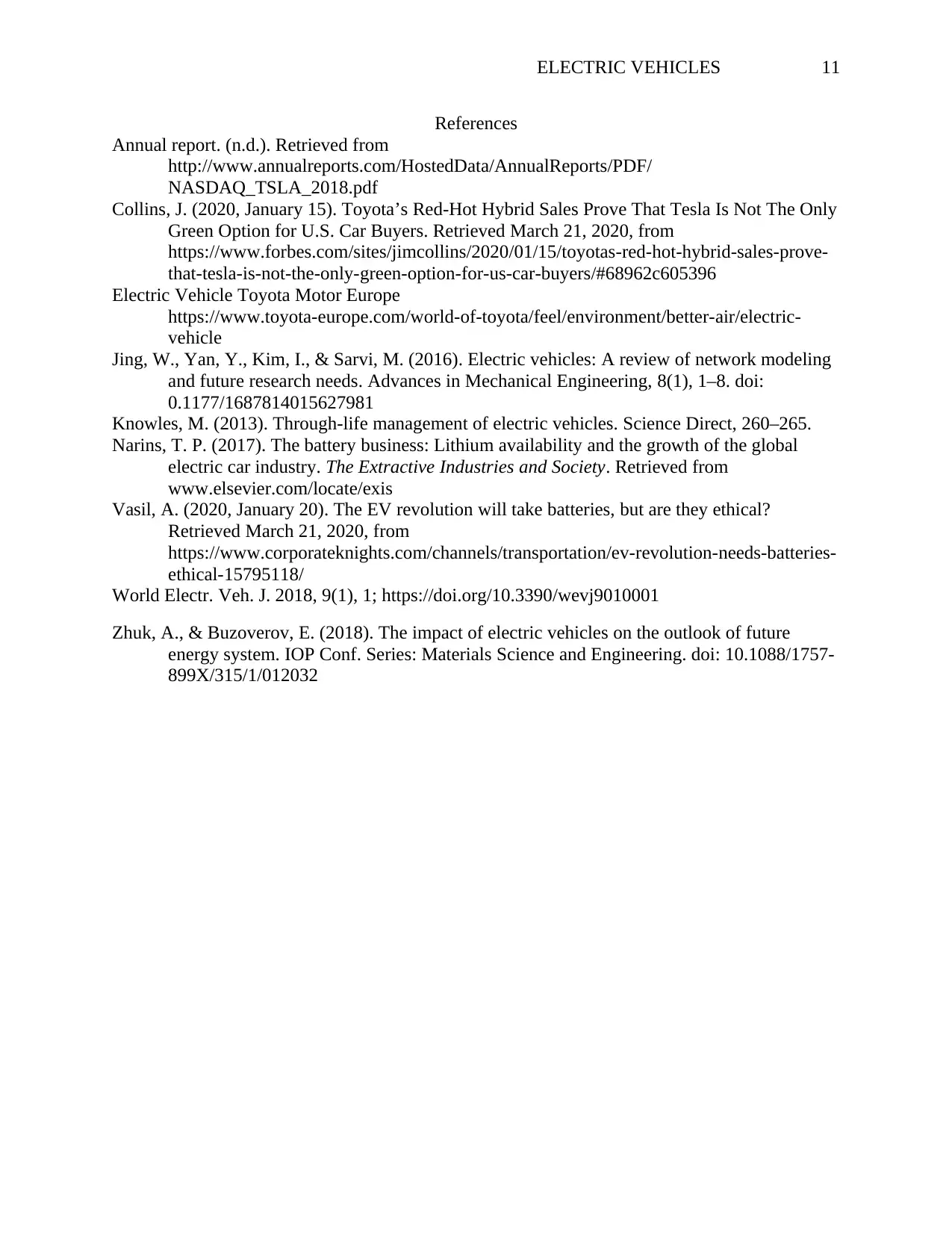
ELECTRIC VEHICLES 11
References
Annual report. (n.d.). Retrieved from
http://www.annualreports.com/HostedData/AnnualReports/PDF/
NASDAQ_TSLA_2018.pdf
Collins, J. (2020, January 15). Toyota’s Red-Hot Hybrid Sales Prove That Tesla Is Not The Only
Green Option for U.S. Car Buyers. Retrieved March 21, 2020, from
https://www.forbes.com/sites/jimcollins/2020/01/15/toyotas-red-hot-hybrid-sales-prove-
that-tesla-is-not-the-only-green-option-for-us-car-buyers/#68962c605396
Electric Vehicle Toyota Motor Europe
https://www.toyota-europe.com/world-of-toyota/feel/environment/better-air/electric-
vehicle
Jing, W., Yan, Y., Kim, I., & Sarvi, M. (2016). Electric vehicles: A review of network modeling
and future research needs. Advances in Mechanical Engineering, 8(1), 1–8. doi:
0.1177/1687814015627981
Knowles, M. (2013). Through-life management of electric vehicles. Science Direct, 260–265.
Narins, T. P. (2017). The battery business: Lithium availability and the growth of the global
electric car industry. The Extractive Industries and Society. Retrieved from
www.elsevier.com/locate/exis
Vasil, A. (2020, January 20). The EV revolution will take batteries, but are they ethical?
Retrieved March 21, 2020, from
https://www.corporateknights.com/channels/transportation/ev-revolution-needs-batteries-
ethical-15795118/
World Electr. Veh. J. 2018, 9(1), 1; https://doi.org/10.3390/wevj9010001
Zhuk, A., & Buzoverov, E. (2018). The impact of electric vehicles on the outlook of future
energy system. IOP Conf. Series: Materials Science and Engineering. doi: 10.1088/1757-
899X/315/1/012032
References
Annual report. (n.d.). Retrieved from
http://www.annualreports.com/HostedData/AnnualReports/PDF/
NASDAQ_TSLA_2018.pdf
Collins, J. (2020, January 15). Toyota’s Red-Hot Hybrid Sales Prove That Tesla Is Not The Only
Green Option for U.S. Car Buyers. Retrieved March 21, 2020, from
https://www.forbes.com/sites/jimcollins/2020/01/15/toyotas-red-hot-hybrid-sales-prove-
that-tesla-is-not-the-only-green-option-for-us-car-buyers/#68962c605396
Electric Vehicle Toyota Motor Europe
https://www.toyota-europe.com/world-of-toyota/feel/environment/better-air/electric-
vehicle
Jing, W., Yan, Y., Kim, I., & Sarvi, M. (2016). Electric vehicles: A review of network modeling
and future research needs. Advances in Mechanical Engineering, 8(1), 1–8. doi:
0.1177/1687814015627981
Knowles, M. (2013). Through-life management of electric vehicles. Science Direct, 260–265.
Narins, T. P. (2017). The battery business: Lithium availability and the growth of the global
electric car industry. The Extractive Industries and Society. Retrieved from
www.elsevier.com/locate/exis
Vasil, A. (2020, January 20). The EV revolution will take batteries, but are they ethical?
Retrieved March 21, 2020, from
https://www.corporateknights.com/channels/transportation/ev-revolution-needs-batteries-
ethical-15795118/
World Electr. Veh. J. 2018, 9(1), 1; https://doi.org/10.3390/wevj9010001
Zhuk, A., & Buzoverov, E. (2018). The impact of electric vehicles on the outlook of future
energy system. IOP Conf. Series: Materials Science and Engineering. doi: 10.1088/1757-
899X/315/1/012032
1 out of 11
Related Documents
Your All-in-One AI-Powered Toolkit for Academic Success.
+13062052269
info@desklib.com
Available 24*7 on WhatsApp / Email
![[object Object]](/_next/static/media/star-bottom.7253800d.svg)
Unlock your academic potential
Copyright © 2020–2025 A2Z Services. All Rights Reserved. Developed and managed by ZUCOL.




